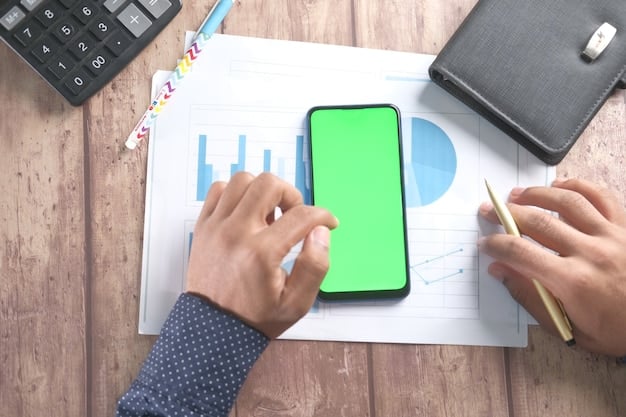Budgeting Apps vs. Spreadsheets: Which Saves You More?

Budgeting apps offer automated tracking and real-time insights, while spreadsheets provide customization and control, but choosing between budgeting apps and spreadsheets depends on your tech comfort, detailing level, and time investment.
Are you trying to get your finances in order and wondering whether to use a budgeting app or a spreadsheet? The choice between budgeting apps vs. spreadsheets: which method saves you more time and money? depends on preferences and financial management style. This article will explore the pros, cons, and features to help you decide which method is best for your financial goals.
Tracking Expenses: Apps vs. Spreadsheets
One of the most fundamental aspects of budgeting is tracking where your money goes. Both budgeting apps and spreadsheets offer methods to monitor your expenses, but they differ significantly in their approach and ease of use. Understanding these differences is crucial in determining which tool aligns best with your lifestyle.
Automated Tracking with Budgeting Apps
Budgeting apps shine when it comes to automatically tracking your expenses. These apps can connect directly to your bank accounts and credit cards, logging transactions in real-time. This feature eliminates the need for manual data entry, saving you time and reducing the chance of human error.
Manual Input with Spreadsheets
Spreadsheets, on the other hand, require you to manually input every transaction. This method can be more time-consuming, but it also provides a higher level of control and detail. You decide exactly how each transaction is categorized and recorded, which can be beneficial if you have unique spending habits.

Ultimately, the choice depends on how you prefer to manage your financial data. Budgeting apps offer convenience and automation, while spreadsheets provide precision and customization. Consider how much time you’re willing to invest in tracking, the simplicity you desire, and whether you value hands-on control. Your choice should align with your organizational preferences.
Customization Options: Tailoring to Your Needs
Personal finance is not one-size-fits-all, and the ability to customize your budgeting tool is important. Both budgeting apps and spreadsheets offer customization, but they cater to different levels and types of personalization. Let’s examine how each tool allows you to tailor your budgeting process.
Flexibility in Spreadsheets
Spreadsheets are unparalleled in their customization options. You can design your budget from scratch, setting up categories, formulas, and reports exactly to your liking. This flexibility is ideal for those with complex financial situations or unique budgeting needs. You can add as many categories as necessary to track every aspect of your cashflow.
Templates & Features in Budgeting Apps
While budgeting apps may not offer the same level of open-ended customization as spreadsheets, they come with templates and features designed to simplify the budgeting process. Most apps allow you to create custom categories, set spending limits, and track your progress towards financial goals. Consider these factors when determining which tool best fits your needs:
- Category Customization: Most apps allow some level of category customization, but more advanced ones will give you the possibility to add as much categories as you want.
- Reporting: Spreadsheets and Budgeting Apps offer different reporting options, so make sure to choose the options that allow you to have the best visualization of your expenses.
- Financial goals: Budgeting Apps usually allow the addition of financial goals, such as paying a mortgage, buying a house, or saving money for a trip, so make sure to check that option as well.
When choosing between budgeting apps and spreadsheets, customization can be pivotal. The adaptability of spreadsheets suits those with intricate financial management needs, whereas budgeting apps’ preset templates provide quick organization to those with fast needs to organize their expenses.
Time Efficiency: Which Saves You More Hours?
In today’s busy world, time is a valuable resource. Choosing a budgeting method that saves you time can significantly improve your adherence to your budget and overall financial health. Let’s see time efficiency between budgeting apps and spreadsheets.
Automation vs. Manual Data Entry
Budgeting apps save time with automated transaction tracking, linking to bank accounts and credit cards for seamless expense logging. This real-time data entry eliminates manual work, providing immediate insights into your spending. This function offers significant value, especially for those tracking expenses daily.
The Learning Curve of Spreadsheets
Spreadsheets require manual data entry and can have a learning curve when setting up formulas and reports. While they offer customization, the initial setup can be time-consuming. However, once established, a spreadsheet can provide detailed financial insights, although it still demands continuous manual updates.

Budgeting apps are best for daily expense tracking, offering real-time spending insights for immediate control. Spreadsheets are better for those who enjoy a one-time detailed setup and don’t mind regular manual updating. They require higher initial time, but can allow a deeper look into personal expenses.
Cost Factors: What’s the Real Price?
Budgeting shouldn’t break the bank. Understanding the cost factors associated with budgeting apps and spreadsheets is crucial for making an economically sound decision. While spreadsheets often have a one-time cost, budgeting apps can come with subscription fees. Let’s break down the cost implications of each.
Subscription Fees vs. One-Time Purchases
Many of the more feature-rich budgeting apps operate on a subscription model, charging a monthly or annual fee. It’s essential to evaluate the cost against the value you receive in terms of automated features, reporting capabilities, and overall financial insights. Free versions often have limited features.
Potential Hidden Costs
While spreadsheets may seem like a one-time purchase, consider potential hidden costs such as software upgrades or the need for additional tools and plugins to enhance functionality. Additionally, the time spent manually managing your budget in a spreadsheet has an implicit value when compared to an app.
When facing the differences between budgeting apps and spreadsheets, subscription fees compared to one-time purchases and potential hidden costs need to be considered. For those prioritizes long-term cost-effectiveness combined with personal data management, spreadsheets can be the better option. However, for those prefer automated tools and ready for a monthly payment, budgeting apps can be the best option.
Security Considerations: Your Data at Risk?
When dealing with personal financial data, security is paramount. Knowing the security measures of budgeting apps and spreadsheets can give you peace of mind and protect you from potential risks. You should be cautious of your personal financial information across any of these methods.
Data Encryption and Privacy Policies
Budgeting apps often use data encryption to protect your financial information. They have privacy policies outlining how your data is collected, used, and shared. It’s essential to review these policies to understand how your data is handled. Look for apps that offer features like two-factor authentication for added security.
Spreadsheet Security
Spreadsheets stored locally on your computer can be secured with password protection. However, if you store your spreadsheets on cloud services like Google Sheets, consider the security measures provided by those platforms. Also, be cautious of sharing your spreadsheets with others, which can increase the risk of unauthorized access.
Secure your financial data when dealing with budgeting apps and spreadsheets, considering data encryption and privacy policies, and spreadsheet storage security. Understanding security measures ensures personal information protection, promoting informed choices for financial management.
Ease of Use: User-Friendly Interfaces
A budgeting tool’s ease of use can significantly impact your commitment to managing finances. Evaluating the user-friendliness of interfaces in budgeting apps and spreadsheets will help determine which method better aligns with your tech comfort and efficiency goals.
Intuitive Apps’ Design
Budgeting apps often designed with intuitive interfaces, simplify navigation, and making features accessible to users with varying levels of financial literacy. Clear icons, simple menus, and automated processes, such as transaction categorization, enhance apps’ accessibility.
Spreadsheets’ Potential Design Challenges
Working with spreadsheets allows total customization but could also lead to complex designs, requiring learning special formulas and design skills. Although templates can ease the process, some users may experience difficulty when tailoring spreadsheets to meet specific budgeting requirements.
The choice between easy-to-use Apps and spreadsheets with customizable potential, will require knowing your financial literacy and tech abilities. Apps appeal to all experience levels, while spreadsheets can be daunting to learn and tailor to finance requirements.
| Key Point | Brief Description |
|---|---|
| 💰 Automated Tracking | Budgeting apps offer automated tracking by connecting to bank accounts. |
| ✍️ Manual Input | Spreadsheets necessitate manual transaction input, ensuring detailed control. |
| 📊 Customization | Spreadsheets provide unmatched customization, ideal for complex needs. |
| 🔒 Security Measures | Apps use encryption, while spreadsheets depend on local or cloud security. |
Frequently Asked Questions
▼
Setting up a budget spreadsheet is easy with templates and guides. While the initial setup might require learning formulas, many templates are available online for free.
▼
Many budgeting apps offer basic version, but premium features usually require a paid subscription. These free versions provide enough to have decent expense control.
▼
Budgeting apps use encryption and security measures to protect your financial data. However, it is essential to use strong passwords and monitor your accounts regularly.
▼
Yes, you can import transaction data from your bank into a spreadsheet. Most banks provide the option to download transaction history in CSV format.
▼
If you dislike budgeting apps, spreadsheets or manual tracking can fit your needs. Choose the method that aligns with convenience, control, and ease of use.
Conclusion
Choosing between budgeting apps and spreadsheets depends on personal priorities. Budgeting apps offer automation and ease of use, while spreadsheets provide customization and control. It is about aligning the tool with your preferences, financial habits, and comfort level for financial success.





